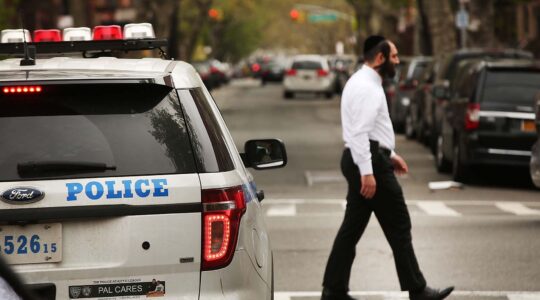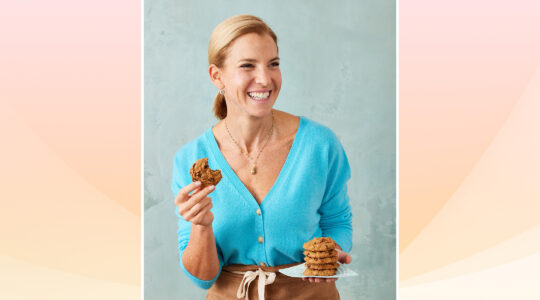Trying to raise three kids on a salary of $37,000, Aileen often faces tough choices about how to divide up her paycheck. After spending $1,100 a month for rent in a three-family home in Queens, $550 on day care for her 4-year-old and paying for other necessities she has little left over to cover incidental expenses.
"There’s $100 left at the end of the month for me and my children," said Aileen, who asked that her last name be withheld to protect her privacy.
A single parent who came to New York in order to provide a more affiliated Jewish life for her children, Aileen now says she’s considering packing up and going back to Oregon. "It was better there," she said. "My expenses were half the price."
Aileen is one of an estimated 104,000 Jews in 53,000 greater New York area households on the verge of poverty because their middle-class income does not cover enough of the rising costs of living, according to a study released last week by the Metropolitan Council on Jewish Poverty.
The near-poor figure is in addition to some 244,000 living below the poverty line, according to previous data collected by Met Council, bringing the overall number of struggling Jews here to one-third of the Jewish population of the five boroughs, Westchester, Suffolk and Nassau.
While it may seem counterintuitive to argue that those with higher incomes are in worse straits than those living below the poverty line, Met Council officials note that a middle-class salary disqualifies the earner from such public assistance programs as food stamps, Medicaid and federal housing assistance, although the need may be the same.
"We have to face the fact that the near-poor need our assistance as much as or more than the poor," said Met Council executive director William Rapfogel in releasing the survey findings last week at the Simon Wiesenthal Center’s Museum of Tolerance in Midtown.
Compiled by David Grossman of the Nova Institute, based on census data as well as the UJA-Federation New York Jewish Population Survey, the near-poor study relied on what Met Council considers a conservative household income, $35,000. Rapfogel said recent studies have used figures as high as $75,000 to define near-poverty in New York. "If we didn’t underestimate the numbers, the alarm in the Jewish community would be so overwhelming that people would be in total denial," he said.
Rapfogel called on local Jewish organizations to increase their efforts to provide aid to struggling families, many of whom are saddled by the high costs of Jewish life (educational, congregational and ritual fees) in addition to normal cost-of-living expenses. "The art of living Jewishly is the art of trying to survive under very difficult conditions," he said. "It all adds up."
The report found that near-poverty cut almost evenly across denominational lines, with 27 percent of respondents identifying as Conservative, 24 percent Orthodox and 22 percent Reform.
The study found that the bulk of near-poor New Yorkers (38,200 people) live in Brooklyn, which has the area’s largest Jewish population. The Brooklyn figure was more than the combined total of Nassau, Suffolk, Westchester, Staten Island and the Bronx.
Staten Island had the lowest figure of near-poor, 1,200 (a mere two percent of the total) while the Bronx, with its shrinking Jewish population, had the second smallest near-poor population, but the largest percentage: 16 percent.
Support the New York Jewish Week
Our nonprofit newsroom depends on readers like you. Make a donation now to support independent Jewish journalism in New York.
Most of the near-poor are working-age adults, ages 18 to 64. Women seem particularly vulnerable. They make up 60 percent of Jewish working near-poor, the study found.
Aileen came to Met Council as a client of its career services department and was soon hired by the agency as a program assistant. While she credits the agency for working to increase her comfort level, she hopes to return to college to complete her degree.
If she could support her children while at school, Aileen says, she could eventually earn another $15,000 to $20,000 a year. While the struggle to make ends meet is hardly a new phenomenon, anecdotal evidence suggests an increasing share of the Jewish community is affected. Met Council said Rosenbloom’s Supermarket in Kew Gardens, Queens (a middle-class, heavily Jewish neighborhood) has been seeing 55-60 families ask for food on credit or work out a payment plan for groceries, and that some $40,000 is owed the store by struggling families.
In Brooklyn, Rabbi Yechezkel Pikus, director of the Council of Jewish Organizations of Flatbush, an affiliate of Met Council, said he has been asked to assist a growing number of families who face foreclosure of their homes.
"We’ve had, in the past two or three months, five cases of houses going to foreclosure," said the rabbi. "Once the process starts it’s very hard to stop it. We try to get a few bucks for them, but once you miss four or five payments you can be in arrears for tens of thousands of dollars."
The rabbi also said his group has regularly been asked by struggling Orthodox families for assistance with yeshiva and camp tuition. "It’s a backbreaker for many of these families," he said. "Because of their determination to live in certain environments and have access to schools, amenities, synagogues and infrastructure, they have bitten off more than they can chew."
The rabbi said his agency had disbursed close to $100,000 in scholarships in recent months, much of it to help kids go to summer camp.
"Parents don’t want their kids to roam the streets [but] to be in a wholesome environment," he said.
Grossman said there was no data available to compare his statistics with those of other communities to determine what portion of the overall near-poor rate Jews comprise.
State Assembly Speaker Sheldon Silver, who attended the press conference announcing the survey, said the findings are "not atypical of what is happening in this state and nation. Working poor men and women who have very much difficulty making ends meet need real solutions."
Silver said the increased minimum wage that went into effect this week may help, but he said increased focus on access to higher education was key.
"We have to make sure we give the opportunity to the next generation of working poor and help them go from Pre-K to B.A.," said Silver.
Support the New York Jewish Week
Our nonprofit newsroom depends on readers like you. Make a donation now to support independent Jewish journalism in New York.
Rapfogel said one of the major obstacles facing the near-poor was a federal government assessment of poverty, known as a "market basket," that does not take into account the disparity of costs in urban areas.
"The market basket has to reflect the extremely wide disparity of different regions of the country," he said. "In New York, Chicago, L.A., it’s more expensive to live than in a rural area. One has to look at that and adjust the poverty level to account for it."
The New York Jewish Week brings you the stories behind the headlines, keeping you connected to Jewish life in New York. Help sustain the reporting you trust by donating today.




